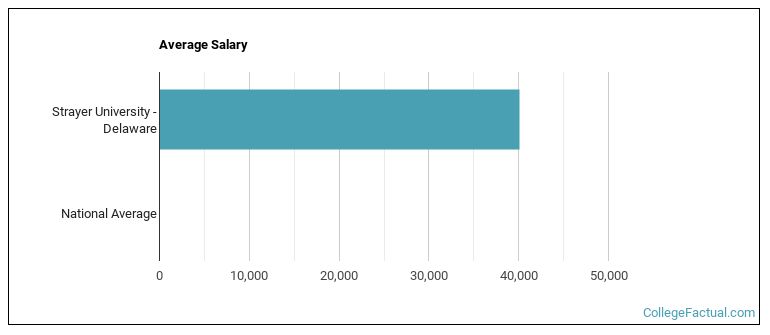 by our College Data Analytics Team
by our College Data Analytics TeamExplore the best ranked schools for the programs you are most interested in.
Strayer University - Delaware was not ranked in College Factual's Best Overall Colleges report this year. This may be because not enough data was available.
Returning adults and other non-traditional students may appreciate the fact that Strayer University - Delaware has an open admissions policy. This means that you'll only have to submit basic materials, which may include proof that you completed high school or an equivalent program.
The student to faculty ratio is often used as a measure to gauge how much access students will have to their professors - the lower the number, the better. At Strayer University - Delaware, this rate is 41 to 1, which is high when compared to the national average of 15 to 1.
In addition to the student to faculty ratio, some people look at what percentage of faculty members are full-time as a sign of how much time professors will be able to spend with their students. This is because part-time teachers may not be be on campus as much as their full-time counterparts.
The full-time faculty percentage at Strayer University - Delaware is 14%. This is lower than the national average of 47%.
The on-time graduation rate for someone pursuing a bachelor's degree is typically four years. This rate at Strayer University - Delaware for first-time, full-time students is 100%, which is better than the national average of 33.3%.
Find out more about the retention and graduation rates at Strayer University - Delaware.
During the 2017-2018 academic year, there were 357 undergraduates at Strayer University - Delaware with 24 being full-time and 333 being part-time.

See which majors at Strayer University - Delaware make the most money.
Get more details about the location of Strayer University - Delaware.

Contact details for Strayer University - Delaware are given below.
| Contact Details | |
|---|---|
| Address: | 800 North King Street Suite 101, Wilmington, DE 19801 |
| Phone: | 877-455-7180 |
| Website: | www.strayer.edu/campus-locations/delaware/wilmington |
| Most Popular Majors | Bachelor’s Degrees | Average Salary of Graduates |
|---|---|---|
| General Business/Commerce | 33 | $55,431 |
| Computer Information Systems | 3 | $67,315 |
| Accounting | 2 | $52,373 |
| Criminal Justice & Corrections | 2 | $43,405 |
| Human Resource Management | 1 | NA |
| Marketing | 1 | NA |
| Information Science | 1 | $71,167 |
| Information Technology | 1 | NA |
| Health & Medical Administrative Services | 1 | NA |
| Business Administration & Management | 0 | NA |
Online learning options are becoming more and more popular at American colleges and universities. Online classes are great for students who have busy schedules or for those who just want to study on their own time.
In 2022-2023, 270 students took at least one online class at Strayer University - Delaware. This is a decrease from the 300 students who took online classes the previous year.
| Year | Took at Least One Online Class | Took All Classes Online |
|---|---|---|
| 2022-2023 | 270 | 270 |
| 2021-2022 | 300 | 300 |
| 2020-2021 | 394 | 394 |
| 2018-2019 | 351 | 329 |
Learn more about online learning at Strayer University - Delaware.
Footnotes
*The racial-ethnic minorities count is calculated by taking the total number of students and subtracting white students, international students, and students whose race/ethnicity was unknown. This number is then divided by the total number of students at the school to obtain the racial-ethnic minorities percentage.
References
More about our data sources and methodologies.